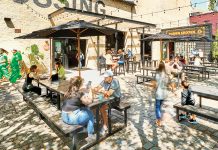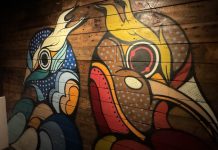WHEN I WAS A KID, an archetypical codger who summered near our cabin would set us kids to gathering wild “shrooms.” We spent hours in the woods, and brought back mushrooms by the grocery-bag full. Joe would identify the edible ones and send us home with half. The rest he dried on a screen above his wood stove.
Joe was Czech, which may have explained his interest in wild fungi. As mushroom enthusiasts point out, there are mycophilic and mycophobic cultures. Eastern Europeans are mycophilic. Consider the poignant, passionate, nearly erotic, scenes of mushroom gathering in Tolstoy’s Anna Karenina: “What is the difference between the ‘birch’ mushroom and the ‘white’ mushroom?” Varenka’s lips quivered with emotion as she answered: “In the top part there is scarcely any difference, it’s in the stalk.”
East Asians, too, relish mushrooms. Japanese dote on shiitake, maitake, and matsutake. In Zhejiang province, in eastern China, I once sat down to a banquet with five courses of mushrooms—a delicate yellow trumpet fungi, another specimen that was large and plump and looked like a chicken breast, large bulbous mushrooms bobbing in broth, others in a glaze, and a brown flat fungi known as pig’s ear. All were mild and delicious, a perfect complement to the bullfrog soup and pig stomach.
Asian mycophilia, however, doesn’t travel well. Last fall, seven Hmong mushroom gatherers wound up in a Twin Cities hospital after eating mushrooms they had picked in Ramsey County parks; one, a 10-year-old girl, died. They had made a common error. They thought they were picking a relative of the edible Paddy Straw mushroom, used in Asian cuisine. Instead, they had cooked up the eastern American destroying angel, which looks similar but ranks among the most poisonous mushrooms.
Such mistakes aren’t a problem for most Americans because, as a rule, we’re mycophobic. “Most people are really afraid of mushrooms,” says Tom Volk, a fungi specialist and professor of biology at the University of Wisconsin–La Crosse. “We get that from the British.” Most of us, if we eat mushrooms at all, consume only the bland white cultivars available at the supermarket. The idea of eating wild mushrooms strikes most people as eccentric or foolhardy.
A couple years ago, my wife, Susan, took an interest in gathering wild mushrooms. As various fungi began to appear on our table, I decided a mushroom guide would make a terrific Christmas present. And not just any guide, but Mushrooms of North America by Roger Phillips. (Out of print, a used copy cost $115 on eBay.) It contains detailed descriptions and more than 1,000 sharp, beautiful color photographs of hundreds of species—edible, poisonous, and otherwise. A great deal at any price—not only a wonderful gift, but also an investment in our survival.
SUSAN HAD ALREADY made the best investment of all, however: she had begun hanging out with people who knew what they were doing.
They were members of the Minnesota Mycological Society, a band of about 125 devoted hobbyists that boasts on its website of “bringing people and mushrooms together for over 100 years.” They meet regularly and publish The Toadstool Review newsletter. Every autumn, they have a mushroom potluck. They are one of many groups around the country affiliated with the North American Mycological Association. Best of all, during the mushroom season they head out on frequent forays (which invariably is what fungi-philes call their outings). Most often they are led by Lee Moellerman, who puffs cigars as his stubby-legged dog Toots huffs along behind.
Members of the Minnesota society continue to foray deep into autumn, even after hard frosts have destroyed all mushrooms except withered puffballs and the leathery bracts on trees and logs. In Lake Maria State Park, I joined two dozen members dressed in winter jackets, gloves, and warm caps. “Good turnout!” I remarked to Moellerman.
“I’ll say,” he said, surprised so many would show in the cold.
Like many club members, Moellerman fell into mushroom hunting because of his interest in other wild edibles. “I was studying herbs and stuff like that. I just happened to find a field guide on mushrooms.”
“You remember Euell Gibbons?” asked Ron Spinosa, a mental-health worker with a master’s in zoology. “I was into that wild-edibles stuff. Mushrooms kind of go right with that. Then I found out about the club.” Spinosa was once the club’s president; now he edits its newsletter. He recently was called to help identify the mushroom that poisoned the Hmong gatherers.
Adele Mehta also turned out on this cold day. A club member for nearly 20 years, she joined after taking an adult-education class on mushrooms. Mehta said she was drawn to the variety of wild fungi. “I think they’re beautiful,” she said. “That’s usually what draws all of us. Can I eat it? It’s the first question. But after that, you just get hooked on the diversity and beauty of mushrooms.”
Even so, Mehta said, “I wouldn’t turn down an edible.” I mentioned that Susan had just prepared a meal of ruffed grouse, bog cranberries, wild rice, and puffball mushrooms. “Isn’t that great?” Mehta exclaimed. “An indigenous meal!”
MUSHROOMS ARE the fruiting body of various fungi, just as an apple is the fruit of a tree. The bulk of the fungi, the mycelium, lives underground. Sometimes it’s entwined in the wood of a standing tree or downed log. Fungi are so ubiquitous it is often said that if all the world’s plants were to disappear, we could still see a forest by the fungi that remained.
Fungi reproduce by releasing tiny spores that are carried great distances by the wind. Though fungi are rooted, recent molecular studies have shown them to belong to their own kingdom—more closely related to animals than to plants.
Depending on the species, fungi scavenge dead material. Or they parasitize living things. Or they live symbiotically with other organisms. Joining with algae, for example, they form lichens. Fungi recycle nutrients as they reduce wood to soil. Without them, we’d be buried in deadwood.
A fungus may be the world’s largest organism. Twenty years ago, scientists discovered a single underground mycelium in Michigan’s Upper Peninsula. It covered more than 30 acres and weighed at least 100 tons, as much as a blue whale. In 2000, researchers found a fungus in eastern Oregon that spread more than three square miles.
The number of fungi species is estimated in the millions. According to David McLaughlin, a professor of plant biology at the University of Minnesota, more than 2,000 species have been cataloged in Minnesota, but the real number is probably three times higher.
“Mycology is one of the few disciplines in which amateurs play a significant role,” Volk says. The number of mushroom researchers is small; so knowledgeable hobbyists help gather data. The Mycological Society, for example, has helped study the abundance of various fungi in old-growth forests in the state. Volk added, “Lots of the people who are avid amateurs know a lot more mushrooms by sight than your average professor does.”
Mushrooms hunters are fond of saying, “You can eat any mushroom once.”
Distinguishing poisonous from nonpoisonous mushrooms often hinges on minute details, such as spore color. The cardinal rule of gathering mushrooms: when in doubt, throw it out.
Fortunately, several prized species are reasonably easy to recognize. Among these are various puffballs (but not all—some look-alikes are poisonous), chicken of the woods (known also as sulphur shelf since it is yellow and grows on trees), king bolete (also known as porcini), oyster, chanterelle, and shaggy mane.
Among the tastiest and easiest to identify is the morel, the state mushroom, perhaps the most coveted fungus in the region. The morel is phallic, wrinkled, and hollow. It has a meaty texture and flavor—a meal in itself or a complement to any dish, wild or domestic. When morels begin to poke above ground in late April and early May, many mushroom fanciers skulk off with burlap bags and baskets, checking the rearview mirror to make sure no one is following. Minnesota Mycological Society members are a refreshing exception in this regard: they welcome veterans and newcomers to join their group on their mid-May forays devoted to finding morels in the hardwoods of southeastern Minnesota.
Several years ago, I joined some members gathered in Elba on a cool, gray day for their annual morel outing. We drove into the hills by caravan to a couple of spots Moellerman had scouted earlier in the week. We scrounged in the duff beneath recently deceased elms. (Morels often live in the root tissue of elms, and when a host tree dies, the morel mycelia send up mushrooms to disperse spores to colonize other roots.) But the weather had been too cool for mushrooms to flourish. We found morels, but only a few, and most were smaller than thumb-sized. A shortcut back to the cars through a steep ravine devolved into what The Toadstool Review later described as a “death march”—an additional frustration on an already disappointing day.
But soon the weather warmed. A week later, Susan and I played hooky with more than just morels in mind. Fly-fishing on the Whitewater River, I caught a foot-long trout. Susan gathered a basket of tender fiddlehead ferns. And then we really lucked out. We spotted a dead elm not far off a dirt road. I slammed on the brakes. We rushed over and found a trove of meaty morels. That evening, with a frying pan and butter, we cooked a real indigenous meal—one with few rivals.
Greg Breining is a writer in St. Paul.






